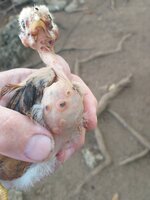Pollo Eric
Chirping
- Jun 11, 2019
- 31
- 93
- 84
I am new here and this may be in the previous posts and I apologize if it is but I wanted to get this out ASAP. I lost one chick a few days ago that was showing same bumps/warts type Mark's, this is the second and only order chick from this hen, about 3 weeks, free range, sleeps in area with wood shavings and does not yet roost. Many chicks from other hens in identicle conditions without problems , I attached a pic, hope it helps
These are hot climate birds , Thank you in advance for your help
These are hot climate birds , Thank you in advance for your help





 Wow, never seen anything like that. Where are you located?
Wow, never seen anything like that. Where are you located? Thank you in advance
Thank you in advance